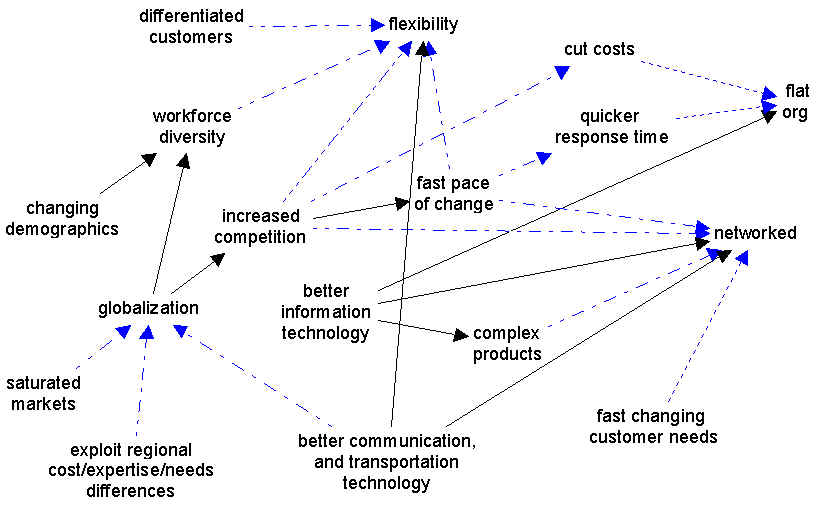21st Century Organizational Trends
There are five key organizational trends that you should be
aware of.
- Increasingly globalized sales, manufacturing, research,
management
- Movement from direct exports to having sales offices in
different countries to having manufacturing to all
functions spread across the globe
- Increasingly globalized labor market
- Due to:
- reduced cost and improved quality of
international transportation and communication
- search for unsaturated markets
- exploit regional cost and expertise differences
- Workforce getting more heterogeneous sexually, racially,
culturally, individually, etc.
- Source of both innovation and conflict/communication
problems
- Need to cope with different styles of interaction, dress,
presentation, physical appearance
- Due to:
- changing demographics
- globalization of the labor market
- Organizational systems and processes and people that can
respond differently to different situations
- Fewer detailed rules and procedures
- Greater autonomy, encouragement for initiative
- Customizable employment relationships: telecommuting, job
sharing, mommy tracks, pay for skills
- Lifetime employability, not lifetime employment
- Due to:
- differentiated customer needs -- filling them
exactly is source of competitive advantage
- increasing diversity in workplace
- increased pace of change in technology and
markets
- Fewer levels of management,
- Workers empowered to make decisions
- Fewer differences in responsibility (not in pay) across
levels
- Due to:
- need for speed, which makes it helpful to empower
employees to make decisions, which means fewer
managers are needed
- changes in information technology mean less need
for the communication and control functions of
middle managers
- globalization means intensified competition,
which increases the need to cut costs
- Direct communication across unit & firm boundaries,
ignoring chain of command
- Cross-unit team structures
- Outsourcing & downsizing
- Strategic alliances with competitors and others
- Now have firms that are your competitors,
customers and collaborators all at the same time
- Close coordination among firms (e.g., JIT systems) and
information sharing (open computer systems)
- Across the board contact with customers, not just
official boundary spanners
- Customization
- Decentralization
- Due to:
- new information technologies, especially
groupware, client-server, distributed computing
- fast changing customer needs and competitor
offerings
- more complicated products require better
integration of manufacturing, design, and
marketing functions
-----------------------------------------
Here is a diagram linking up all the concepts above.

The dashed arrows with blue heads
mean "creates the need for", while the solid arrows
with black heads mean "causes" or "enables".
| Copyright
©1996 Stephen P. Borgatti |
Revised: February 05, 2001 |
Go to Home page |

